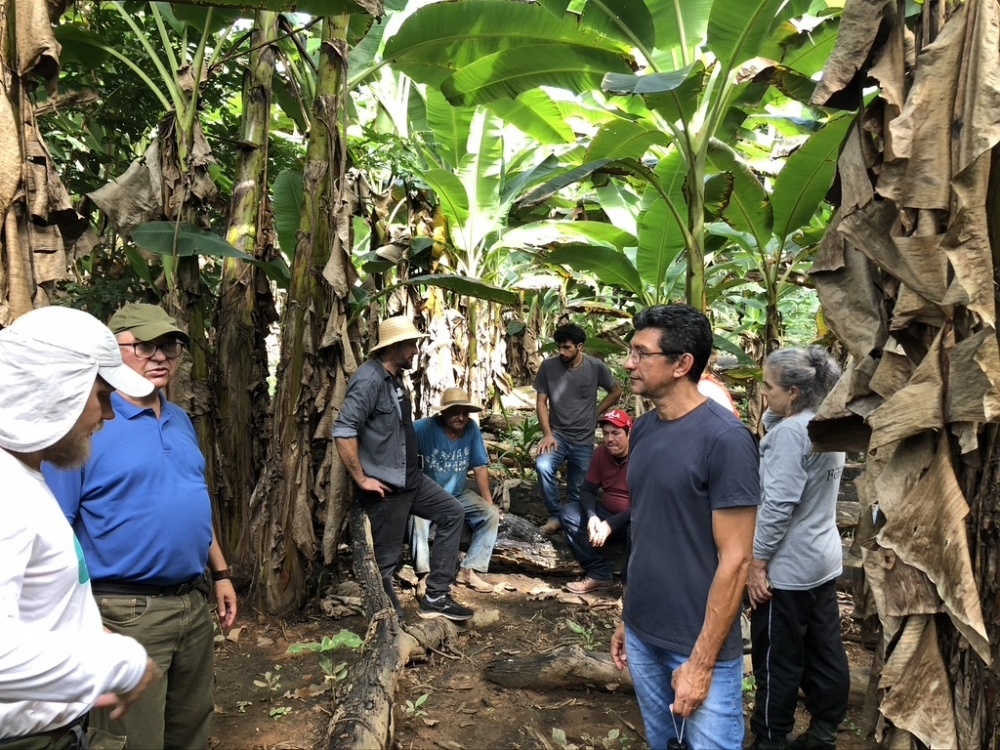


Strategies for reconciling forest conservation and income generation for families living on Chico Mendes Extractive Reserve in Acre state are the focus of a project in which local scientists are collaborating with colleagues from the states of São Paulo and Pará. The project is part of the Amazon+10 Initiative (photo: agroforestry system on Chico Mendes Extractive Reserve visited in June by socio-economic and environmental working groups; credit: GT Socioeconomia)
Published on 07/17/2023
By André Julião | Agência FAPESP – In Brazil, livestock can be an important store of value for families that make a living from forest product harvesting and small-scale farming. In times of poor harvests or emergencies, one or more animals can be sold to raise money quickly.
In the Brazilian Amazon, however, livestock raising is one of the main enemies of conservation of the biome, on which the planet depends for regulation of its climate. More locally, the Amazon is an essential source of the rainfall required by farmers in the Center-West and Southeast of Brazil. Moreover, the financial return from livestock production is often unsatisfactory compared with the return from other activities.
In response to these issues, a project supported by FAPESP will assess and monitor alternatives to deforestation on the Chico Mendes Extractive Reserve in Epitaciolândia, Acre state. Established in 1990 in the wake of campaigns waged by Chico Mendes and other labor union leaders, the reserve now has some cattle and small plantations as well as rubber and Brazil nut trees.
The project is part of the Amazon+10 Initiative, which received proposals for research projects in the region through the National Council of State Research Foundations (CONFAP).
Each of the 39 projects selected in the first call for proposals and announced at the end of 2022 is led by principal investigators from institutions in at least three states whose research foundations have joined the program (read more at: agencia.fapesp.br/38991/).
“Extractive reserves are conservation units where traditional communities that use the land sustainably can live. The Chico Mendes Extractive Reserve has a management plan that allows each settlement to use up to 10% of its area, limited to 30 hectares, for farming, livestock raising, fish production and agroforestry activities,” said Lucas Ferreira Lima, a researcher on the project and a postdoctoral fellow at the State University of Campinas’s Institute of Economics (IE-UNICAMP) in São Paulo state.
The area devoted to livestock raising in the reserve is increasing owing to low labor costs and the attractive return on the activity, he explained. “However, we’re analyzing alternatives such as agroforestry systems and rubber tapping, which offer higher levels of income without destroying the forest,” he said.
Besides UNICAMP, the researchers involved in the project are affiliated with the Federal University of Acre (UFAC) and the Federal University of Pará (UFPA). The project has four working groups. One will analyze social and economic aspects, especially the performance of the families engaged in alternative activities that avoid deforestation.
An environmental working group will analyze the effectiveness of agroforestry systems in terms of conservation of terrestrial and aquatic biodiversity, as well as their ecosystem-related functions.
A third working group, called forest recomposition, will promote regeneration of the vegetation in two Permanent Conservation Areas (APPs). The fourth is known as science diffusion and will produce audiovisual material for the project’s YouTube channel.
“We expect to garner a clearer understanding of the factors that could effectively make forest harvesting activities more attractive again, compared with the high rate of return provided by livestock raising. The preliminary information obtained suggests that economic incentives alone, without effective combination with command-and-control policies, won’t guarantee conservation of the forest,” said Ademar Ribeiro Romeiro, principal investigator for the project and a professor at IE-UNICAMP.
Alternatives
Shipping is one of the bottlenecks faced by local farmers. During the rainy season, between October and April, the roads are impassable, freshly picked fruit is lost, and rubber collected in the forest cannot be sent outside the reserve. One of the alternatives to be studied entails local processing of cocoa beans, cupuassu seeds, Brazil nuts and other forest products. Jam, sweets, biscuits and similar value-added products made from these raw materials last longer and sell for higher prices.
“Even so, there are producers on the reserve who have run agroforestry systems for more than 20 years with good results. They have neighbors who regret having cleared the forest to raise cattle. Although livestock is a store of value, it doesn’t provide as much monthly income as a plantation, which can produce in all seasons and maintains some of the forest’s functions,” said Oleides de Oliveira, a professor at UFAC and a researcher on the project.
Local rubber tappers also earn more than livestock producers. All the rubber harvested on the reserve is supplied to a footwear manufacturer, which has entered into a long-term agreement to buy the raw material and encourages other members of the community to return to rubber tapping, the activity symbolized by Chico Mendes when the reserve was created.
“Many of the people who gave up rubber tapping are returning to the activity, tapping the native trees or collecting latex from new trees planted for this purpose. The footwear company adds value to the product by affixing a sustainable rubber seal,” Oliveira said.
The reserve has 970,570 hectares. The researchers made their first visit as part of the project in June. They plan to conduct interviews with some of the 100 families in the study sample in September, collecting information for an initial analysis that will serve as a basis for recommending alternatives to deforestation and livestock raising.
Part of a degraded area has been fenced off and will receive seedlings before the end of this year. Ecological analysis is due to start soon.
“We will look for criteria, values and fundamental viewpoints from the community. We will use these as a basis for recommending alternatives to deforestation that match these values so that they are sustainable for future generations,” Lima said.
Source: https://agencia.fapesp.br/41918